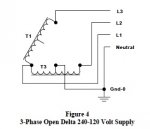Strathead
Senior Member
- Location
- Ocala, Florida, USA
- Occupation
- Electrician/Estimator/Project Manager/Superintendent
So, one of my journeymen was asked to read the frequency of an open delta (with neutral stinger) system at the panel. He read the following with a Klein meter that has a frequency switch setting.
A-N 60hz
B-N 60hz
A-B 60hz
however...
C-N 320hz
C-A 420hz
C-B 520hz
Is there a theory reason for this? Or is there are problem with the system?
I don't think I have ever been asked to read frequency.
A-N 60hz
B-N 60hz
A-B 60hz
however...
C-N 320hz
C-A 420hz
C-B 520hz
Is there a theory reason for this? Or is there are problem with the system?
I don't think I have ever been asked to read frequency.


